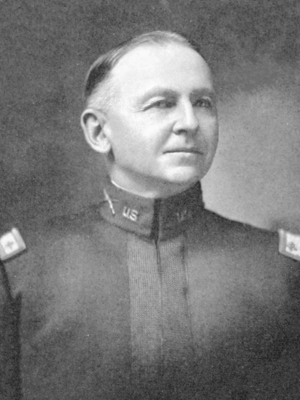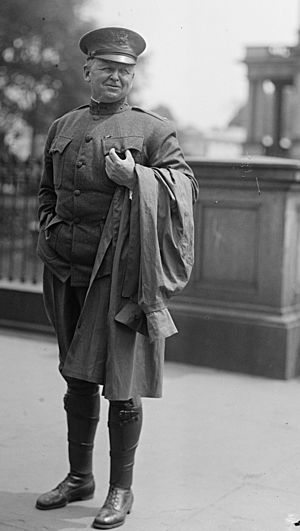Joseph Compton Castner facts for kids
Quick facts for kids
Joseph Compton Castner
|
|
|---|---|

Brigadier General Joseph C. Castner, Commanding the Ninth Infantry Brigade from May 10, 1918
|
|
| Born | November 18, 1869 New Brunswick, New Jersey |
| Died | July 8, 1946 (aged 76) |
| Service/ |
United States Army |
| Rank | Major general |
Joseph Compton Castner (born November 18, 1869 – died July 8, 1946) was an important general in the United States Army. He led the Ninth Infantry Brigade during World War I as part of the American Expeditionary Forces.
Contents
Early Life and Education
Joseph Castner was born in New Brunswick, New Jersey, on November 18, 1869. His father, Cornelius W. Castner, was a captain in the American Civil War. In 1891, Joseph graduated from Rutgers College (now Rutgers University) with a degree in Civil Engineering.
Military Career and Achievements
Joseph Castner began his army career on August 1, 1891, as a Second Lieutenant. He steadily rose through the ranks, becoming a First Lieutenant, Captain, Major, Lieutenant Colonel, and Colonel. By April 12, 1918, he was promoted to Brigadier General. He also attended important military schools, including the Infantry and Cavalry School and the U.S. Army War College.
Before World War I
Even before World War I, Castner showed great skill. As a Lieutenant, he explored parts of Alaska during the Glenn Expedition. In the Philippines, he was promoted to Captain for his work with the Tagalog Scouts. Later, he helped manage construction projects in Honolulu and Yellowstone National Park.
As a Captain, he trained a battalion (a large group of soldiers) that became very good at shooting. As a Major, he improved the District of Columbia Army National Guard. As a Colonel, he led the Thirty-eighth Infantry, which became known as the "Rock of the Marne" for its bravery.
World War I Service
As a Brigadier General, Castner took command of the Ninth Infantry Brigade. He trained his soldiers well for the big battles ahead.
In the Battle of Saint-Mihiel, his brigade helped push the enemy back. They moved their front lines close to the Hindenburg Line, a strong German defense.
During the first part of the Meuse–Argonne offensive, Castner's Brigade captured the town of Cunel. They also drove the enemy out of two important forests. In the second part of the Meuse-Argonne Offensive, his brigade captured several more towns and areas. They then managed a difficult crossing of the Meuse River. After crossing, they fought northward and captured more towns and a large forest.
For his excellent service in the Meuse-Argonne Operation, Castner received the Distinguished Service Medal. This is a very high award for bravery and leadership.
After the war, while his brigade was part of the Army of Occupation, Castner studied artillery at a special center in Trier, Germany. He later retired while commanding the Third Division in the Western United States.
Death and Legacy
Joseph Castner died on July 8, 1946. He was buried at San Francisco National Cemetery.
Two places in Alaska, Mount Castner and Castner Glacier, are named in his honor. These places are in the area he explored in 1898.


